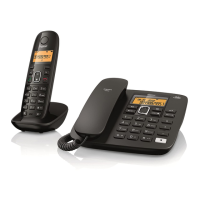
Do you have a question about the Gigaset A590 and is the answer not in the manual?
Detailed descriptions of all handset keys and their functions.
Explanation of display modes and status icons on the handset.
Overview of the keys and their functions on the base station.
Details on the base station display and its status icons.
Essential safety instructions for using the Gigaset phone and avoiding hazards.
Procedure to follow if the handset comes into contact with liquid.
Guidelines for the environmentally sound disposal of electrical and electronic products.
List of items included in the Gigaset A590 package.
Instructions for positioning the base station and charging cradle.
Step-by-step guide to connect the base station to power and the phone line.
Guide to connect the handset charging cradle to the power outlet.
Instructions for initial handset preparation, including battery insertion.
Steps for the first full charging and discharging cycle for optimal battery performance.
Instructions on how to power the handset on and off.
Configuring the correct date and time for call logs and alarms via the base.
Methods for entering characters, numbers, and correcting input errors.
Managing keypad lock and switching the handset ringer on or off.
Using the control key and menu system for phone functions.
Visual representation of the phone's menu hierarchy and available functions.
Accessing and managing contacts, speed dial, and call-by-call numbers.
Configuring handset name, tone, auto answer, date, time, and alarms.
Managing PIN, registration, reset options, prefix, flash time, and dial mode.
Steps for initiating, receiving, and concluding external calls on the handset.
Managing volume, muting, and handling incoming calls during an active call.
Utilizing speed dial shortcuts and call-by-call numbers for efficient dialing.
Procedures for making, receiving, and ending calls using the base station.
Using hands-free mode and adjusting audio volumes during calls.
Using call-by-call numbers from the base station for economical calls.
Explanation of Caller Line Identification service and its prerequisites.
Managing incoming calls, dialing, storing, and deleting entries on the handset.
Viewing, dialing from, and managing entries in the base station's call list.
Operations for viewing, dialing, storing, and deleting entries in the last number redial list.
Functions for storing, viewing, dialing, and managing contacts in the handset phonebook.
Modifying existing contacts and removing entries from the phonebook.
Configuring speed dial shortcuts and storing call-by-call numbers.
Steps for storing, viewing, editing, dialing, and deleting entries on the base station's phonebook.
Steps for adding new handsets and removing existing ones from the base station.
Finding lost handsets and making internal calls between registered devices.
Methods for transferring incoming or ongoing calls to other registered handsets.
Initiating, participating in, and concluding conference calls with internal and external parties.
Making internal calls, handling incoming calls during internal calls, and consultation calls from the base.
Accessing and modifying handset settings for name, tone, auto answer, date, time, and alarms.
Customizing handset name, ringer volume, melodies, and key beep sound.
Setting the device's date, time, and configuring alarm clock functions.
Configuring the date and time settings for the base station.
Adjusting base station ringer volume and managing the security PIN.
Resetting settings to default and configuring the phone for PABX systems.
Rules and character mapping for entering text on the handset.
Overview of technical specifications and recommended battery types for the device.
